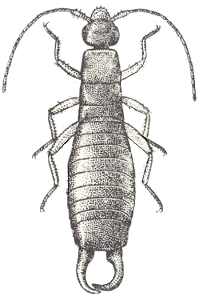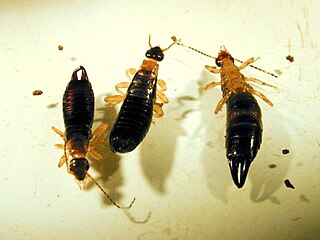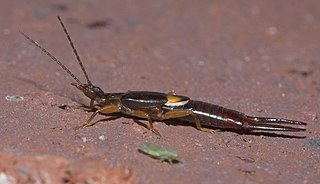
Pygidicranidae is a family of earwigs in the suborder Neodermaptera. The family currently contains twelve subfamilies and twenty six genera. Eight of the subfamilies are monotypic, each containing a single genus. Of the subfamilies, both Astreptolabidinae and Burmapygiinae are extinct and known solely from fossils found in Burmese amber. Similarly Archaeosoma, Gallinympha, and Geosoma, which have not been placed into any of the subfamilies, are also known only from fossils. Living members of the family are found in Australia, South Africa, North America, and Asia. The monotypic genus Anataelia, described by Ignacio Bolivar in 1899, is found only on the Canary Islands. As with all members of Neodermaptera, pygidicranids do not have any ocelli. The typical pygidicranid bodyplan includes a small, flattened-looking body, which has a dense covering of bristly hairs (setae). The pair of cerci at the end of the abdomen are symmetrical in structure. The head is broad, with the fourth, fifth and sixth antenna segments (antennomeres) that are not transverse. In general Pygidicranids also have equally sized ventral cervical sclerites, and in having the rearmost sclerite separated from, or only touching the center of the prosternum. Cannibalism of young has been observed in at least one species in the family, Challia hongkongensis, in which an adult female was found eating a still-living nymph of the same species. The same species in a different area has been observed possibly eating fruits or seeds, making the species an omnivore.

Forficulidae is a family of earwigs in the order Dermaptera. There are more than 70 genera and 490 described species in Forficulidae.

Anisolabis is a genus of mostly Asian earwigs in the subfamily Anisolabidinae. It was cited by Srivastava in Part 2 of Fauna of India. The name Anisolabis stems from the asymmetry of the male cerci; the right cercus being more acute than the left.

Euborellia is a genus of earwigs in the subfamily Anisolabidinae. This genus, which has a world-wide distribution, was erected by Malcolm Burr in 1909 and was cited by Srivastava in Part 2 of Fauna of India.

Diplatyidae is a family of earwigs in the suborder Neodermaptera. It contains three subfamilies, and four genera incertae sedis, one modern and three extinct known from fossils.
Karschiellidae is the sole family of earwigs in the superfamily Karschielloidea. Like the family Diplatyidae, Karschiellidae is a relatively small family with few members.

Labiinae, whose members are commonly known as little earwigs, is a moderately sized subfamily of earwigs in the family Spongiphoridae. It is a cosmopolitan family, whose members are small, winged earwigs, generally less than 1.5 centimetres (0.59 in) in length.
This taxonomy of the Dermaptera follows Engel & Haas (2007) to the rank of tribe.
Allodahlia is a genus of Asian earwigs in the family Forficulidae.

Vostox is a genus of earwigs in the family Spongiphoridae, found in the Americas. There are more than 20 described species in Vostox.

Marava is a genus of earwigs in the family Spongiphoridae; most records are from the Americas, but M. arachidis is cosmopolitan. There are more than 50 described species in Marava.

Neodermaptera, sometimes called Catadermaptera, is a suborder of earwigs in the order Dermaptera. There are more than 2,000 described species in Neodermaptera.
Ancistrogastrinae is a subfamily of earwigs in the family Forficulidae. There are about 6 genera and more than 30 described species in Ancistrogastrinae.

Opisthocosmiinae is a subfamily of earwigs in the family Forficulidae. There are about 18 genera and more than 100 described species in Opisthocosmiinae.
Skendylinae is a subfamily of earwigs in the family Forficulidae. There are about 12 genera and more than 60 described species in Skendylinae.
Echinosoma is a genus of earwigs in the family Pygidicranidae, erected by Audinet-Serville in 1838.
Haplodiplatys is a genus of Asian earwigs erected by Walter Douglas Hincks in 1955. It is the only member of the monotypic family Haplodiplatyidae, with many species originally placed in the genus Diplatys; a key to them was prepared by Alan Brindle.
Diplatys is a genus of Asian earwigs, in the family Diplatyidae, erected by Jean Guillaume Audinet-Serville in 1831. The recorded distribution of species is from Indochina, although this may be incomplete; it is also worth noting that other genera in subfamily Diplatyinae and the genus Haplodiplatys historically have been placed here.

The Spongiphorinae are a medium-sized subfamily of earwigs in the superfamily Forficuloidea, sometimes called "little earwigs", erected by Karl Wilhelm Verhoeff in 1902. Distribution records appear to be incomplete, but genera such as Spongiphora originate from the Americas including the Caribbean; certain species such as Marava arachidis, have a cosmopolitan distribution.











